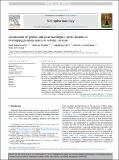Files in this item
Canalization of genetic and pharmacological perturbations in developing primary neuronal activity patterns
Item metadata
| dc.contributor.author | Charlesworth, Paul | |
| dc.contributor.author | Morton, Andrew | |
| dc.contributor.author | Eglen, Stephen J | |
| dc.contributor.author | Komiyama, Noboru H | |
| dc.contributor.author | Grant, Seth G N | |
| dc.date.accessioned | 2015-08-27T14:10:02Z | |
| dc.date.available | 2015-08-27T14:10:02Z | |
| dc.date.issued | 2015 | |
| dc.identifier | 207298168 | |
| dc.identifier | c4ded30b-07ef-4441-84dd-11f592c56511 | |
| dc.identifier | 26211975 | |
| dc.identifier | 84942365437 | |
| dc.identifier.citation | Charlesworth , P , Morton , A , Eglen , S J , Komiyama , N H & Grant , S G N 2015 , ' Canalization of genetic and pharmacological perturbations in developing primary neuronal activity patterns ' , Neuropharmacology , vol. In press . https://doi.org/10.1016/j.neuropharm.2015.07.027 | en |
| dc.identifier.issn | 0028-3908 | |
| dc.identifier.uri | https://hdl.handle.net/10023/7339 | |
| dc.description | PC, AM, NHK and SGNG were supported by the Wellcome Trust Genes to Cognition programme and European Union programs (Project GENCODYS no. 241995, Project EUROSPIN no. 242498 and Project SYNSYS no. 242167) and SJE was supported by the CARMEN e-science project (www.carmen.org.uk) funded by the EPSRC (EP/E002331/1). | en |
| dc.description.abstract | The function of the nervous system depends on the integrity of synapses and the patterning of electrical activity in brain circuits. The rapid advances in genome sequencing reveal a large number of mutations disrupting synaptic proteins, which potentially result in diseases known as synaptopathies. However, it is also evident that every normal individual carries hundreds of potentially damaging mutations. Although genetic studies in several organisms show that mutations can be masked during development by a process known as canalization, it is unknown if this occurs in the development of the electrical activity in the brain. Using longitudinal recordings of primary cultured neurons on multi-electrode arrays from mice carrying knockout mutations we report evidence of canalization in development of spontaneous activity patterns. Phenotypes in the activity patterns in young cultures from mice lacking the Gria1 subunit of the AMPA receptor were ameliorated as cultures matured. Similarly, the effects of chronic pharmacological NMDA receptor blockade diminished as cultures matured. Moreover, disturbances in activity patterns by simultaneous disruption of Gria1 and NMDA receptors were also canalized by three weeks in culture. Additional mutations and genetic variations also appeared to be canalized to varying degrees. These findings indicate that neuronal network canalization is a form of nervous system plasticity that provides resilience to developmental disruption. | |
| dc.format.extent | 1837350 | |
| dc.language.iso | eng | |
| dc.relation.ispartof | Neuropharmacology | en |
| dc.subject | Synapse | en |
| dc.subject | Neuron | en |
| dc.subject | Network | en |
| dc.subject | Mutation | en |
| dc.subject | Canalization | en |
| dc.subject | RC0321 Neuroscience. Biological psychiatry. Neuropsychiatry | en |
| dc.subject | NDAS | en |
| dc.subject.lcc | RC0321 | en |
| dc.title | Canalization of genetic and pharmacological perturbations in developing primary neuronal activity patterns | en |
| dc.type | Journal article | en |
| dc.contributor.sponsor | EPSRC | en |
| dc.contributor.institution | University of St Andrews. School of Physics and Astronomy | en |
| dc.identifier.doi | https://doi.org/10.1016/j.neuropharm.2015.07.027 | |
| dc.description.status | Peer reviewed | en |
| dc.identifier.url | http://www.sciencedirect.com/science/article/pii/S0028390815300344#appd001 | en |
| dc.identifier.grantnumber | EP/E002331/1 | en |
This item appears in the following Collection(s)
Items in the St Andrews Research Repository are protected by copyright, with all rights reserved, unless otherwise indicated.

